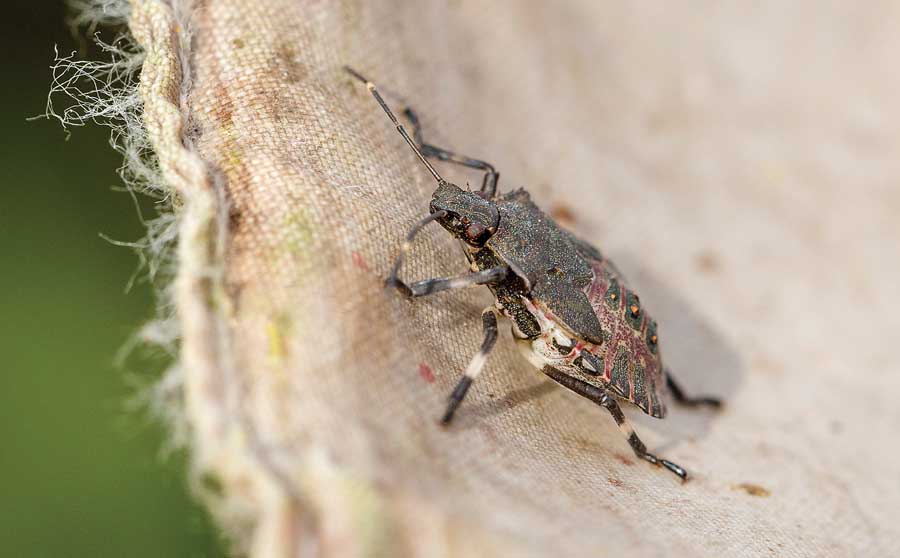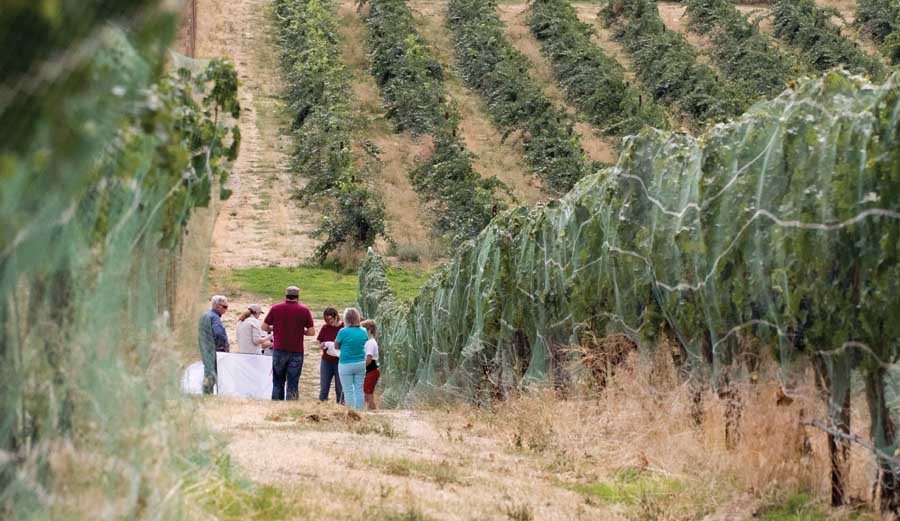
An brown marmorated nymph in it’s fifth instar stage is caught in a researchers net during a search for stink bugs at Walla Walla, Washington area vineyards on October 2, 2015. (TJ Mullinax/Good Fruit Grower)
As the invasive brown marmorated stinkbug spreads in the Pacific Northwest, researchers have a message for growers: don’t panic, but be alert.
Brown marmorated stinkbug populations throughout the United States are spreading from city centers into commercial agriculture.
This past growing season in the Northwest, the dreaded bugs from Asia were confirmed in a few commercial pear orchards on both the Washington and Oregon sides of the mid-Columbia River (near Hood River, Oregon) and in two commercial vineyards near Walla Walla, Washington.
The pest is already found near wine grapes, hazelnuts, and berries in Oregon’s Willamette Valley and in southern Oregon. Researchers have observed the stinkbug feeding on vegetative tissues and grape berries, potentially causing contamination of wine grapes and wine quality.

A multi-agency team of researchers visit two Walla Walla, Washington area vineyards on October 2, 2015 to investigate reports of brown marmorated stinkbug and collect samples. (TJ Mullinax/Good Fruit Grower)
California also has a spreading population of stinkbug. As of September, reproductive populations of brown marmorated stinkbug have been identified in eight counties and the pest has been intercepted in another 20.
Though it has spread quickly, as of mid-October there were no reports of stinkbug in California farms or economic damage, according to Charlie Pickett of the California Department of Agriculture.
With one exception, brown marmorated stinkbug on the West Coast has not caused the severe economic damage experienced a few years ago by East Coast growers—losses that ranged in the millions of dollars.
The exception is Joe’s Place Farms, an 80-acre diversified farm in Vancouver, Washington. Joe Beaudoin of Joe’s Place has experienced stinkbug damage in peaches, apples, and some vegetables for the last three years.
National effort
Some 50 scientists from multiple disciplines across the country have been working on a host of issues related to the pest, which first showed up in the U.S. in the mid 1990s.
Dr. Tracy Lesky, scientist with U.S. Department of Agriculture in West Virginia, leads the national research project that is in its fifth and final year. The research is part of the Specialty Crop Research Initiative and funded through the Farm Bill.
A major component of the project is to develop traps so growers can monitor populations and develop control strategies. As a result of the research effort, pheromone lures are commercially available from several companies.
Traps have also improved in design.
Dr. Peter Shearer, entomologist for Oregon State University, leads the West Coast component of the national project. Shearer, based at OSU’s Mid Columbia Agricultural Research and Extension Center in Hood River, said refinements have been made to trap designs but timing of when traps catch the most bugs is still a weakness.
With most traps, Shearer says, the majority of stinkbugs are caught in the fall. However, spring is the preferable time because the overwintered adults are not as robust and more vulnerable to sprays than stinkbugs caught in the fall.
Traps alert growers to the presence of brown marmorated stinkbug, but growers need to know what the trap numbers mean, he explains. Researchers are working to match the numbers found in traps to damage in orchards so they can determine thresholds that would trigger spray decisions.
“The threshold number for brown marmorated stinkbug probably won’t be a single, universal number,” said Shearer, who believes that economic thresholds will likely be different for nymphs caught versus adults and will probably vary by crop. “For instance, peaches are susceptible all season long, while apples become more susceptible as the season progresses.”
He noted that researchers recently confirmed that the number of generations varies by region. Three years of study identified two complete generations in Oregon’s Hood River compared to only one generation on the East Coast.
“Even though we are a more northern latitude than Allentown, Pennsylvania, where the pest was first established and one generation identified, our warmer summers are resulting in an extra generation,” he said.
A high priority of the project is to develop effective biological control that uses natural predators.
Mid-Atlantic tree fruit growers impacted by brown marmorated stinkbug have learned that chemical control is difficult and can turn IPM programs upside down.
Control is challenging because stinkbug can overwinter in protected places and move in and out of orchards.
Many entomologists, including Shearer, believe biological control will be the saving grace for growers in the future.
Researchers are studying several parasitoid wasps, some collected in Asia. It was earlier reported that a promising imported species—Trissolcus japonicus—wouldn’t make it out of quarantine because it was found to also go after native stinkbug species.
But recently, T. japonicus have been found in the wild near brown marmorated stinkbug populations on both East and West coasts, according to Shearer, indicating that the beneficial wasp is already here.
Washington State University in October publicized the discovery of the wasp in the leaves of a maple tree in Vancouver, Washington, first on August 14 and again on September 23. (Read about that discovery at goodfruit.com.)
Be alert

Dr. Betsy Beers, Washington State University entomologist, prepares to take a photo of a brown marmorated stinkbug in a Walla Walla, Washington area vineyard on October 2, 2015. Beers joined several researchers investigating reports of BMSB sightings and collect samples. (TJ Mullinax/Good Fruit Grower)
Dr. Betsy Beers, WSU entomologist, advises Northwest growers to be on the lookout for the stinkbug.
“It’s not time for Northwest growers to hit the panic button yet, but growers need to be on the lookout for the pest,” she said.
Beers is collaborating with Shearer and others on the national research project and was part of a team that visited Walla Walla in early fall to collect brown marmorated stinkbug for research purposes and see firsthand its habits and host preferences.
The Walla Walla stinkbug finds in two vineyards were not surprising because of their proximity to the city, she noted.
“We had a pretty sure idea that it was already established in the city of Walla Walla from previous reports. We had to look really hard to find the one or two stinkbugs in the two vineyards we visited, but there were plenty of stinkbugs in city trees and in trees near one of the vineyards.”
The stinkbugs in commercial pear orchards of the Mid-Columbia region were caught in traps and also found through scouting. Shearer reported that some fruit damage was evident, though not at economic levels, but it was unclear if the damage came from brown marmorated stinkbug or native stinkbug species.
Beers urges Northwest growers east of the Cascade Mountains to bring suspected brown marmorated stinkbugs into their local extension office or extension research center for identification. The pest is already established west of the Cascade Mountains.
“We want to monitor its spread and range of expansion,” she said. Researchers are most interested in learning if stinkbug is moving into agricultural regions, such as the Yakima Valley, Columbia Basin, and Wenatchee. •
– by Melissa Hansen






I live in Kelso Washington and have killed many of these in my home in the last several months. I only saw a couple last year. Suggestions please.
I use dawn dish soap with waster to spray them when I see them on side of the house. It works. Larry Kaler in Kent WA.
That’s 1 part Dawn dish soap to about 10 parts WATER.
Spotted here in Randle Washington . I believe the bugs are coming in on wood.